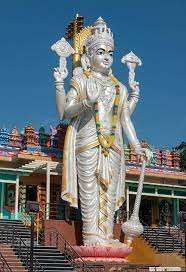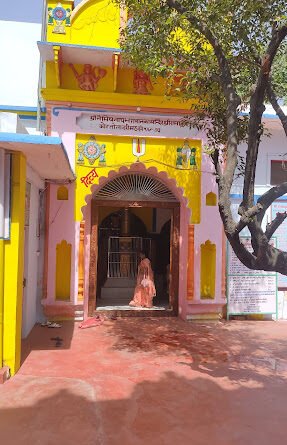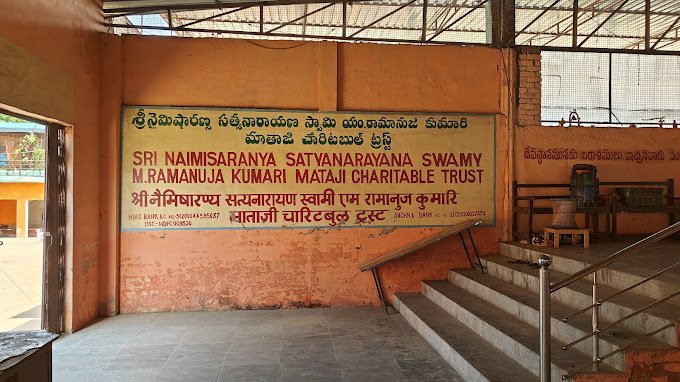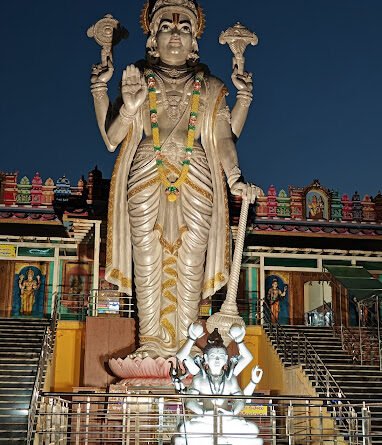Shri Naimishnath vishnu temple
Shri Naimishnath Vishnu Temple, also known as the Naimishnath Devaraja temple or Naimishnarayan Temple or ramanujar kot Temple is a Hindu temple dedicated to Vishnu and lakshmi located in the north Indian state of Uttar Pradesh in naimisharanya town in sitapur district.[1] It is one of the Divya Desams, the 108 temples of Vishnu revered in Nalayira Divya Prabandham by the 12 poet saints called the Alvars. The temple is believed to be of significant antiquity with contributions at different times from the ruling kings. The temple is counted as one of the eight temples of Vishnu that self-manifested and is classified as Swayamvyaktha Kshetra. The holy teerths Chankra Kunda and gomati river are associated with the temple and it is a pilgrimage centre where people take a holy dip during festive occasions.
Legend
Indra, the king of the devas, was once driven out of Devaloka by an asura named Vritra. The asura was the recipient of a boon whereby he could not be killed by any weapon that was known till the date of his receiving the boon and additionally that no weapon made of wood or metal could harm him. Indra, who lost all hope of recovering his kingdom, went to Brahma, Brahma advised indra to perform penance of vishnu at naimish forest, then indra performed penance for 2000 year. Vishnu appeared to him at the end of penance at the exact spot where today vishnu murti (syambhu murti) is standing inside the temple in garb griha and revealed Indra that only the weapon made from the bones of the sage Dadhichi would defeat Vritra. Indra and the other devas therefore approached the sage, whom Indra had once beheaded, and asked him for his aid in defeating Vritra. Dadhichi acceded to the devas’ request, but said that he wished that he had time to go on a pilgrimage to all the holy rivers before he gave up his life for them. Indra then brought together all the waters of the holy rivers to Naimisaranya, thereby allowing the sage to have his wish fulfilled without a further loss of time. Dadhichi is then said to have given up his life by the art of yoga after which the devas fashioned the Vajrayudha from his spine. This weapon was then used to defeat the asura, allowing Indra to reclaim his place as the king of Devaloka.[2]And then appeared to lord vishnu and requested him to appear at the place where he performed penance. Vishnu appeared as a syambhu black murti in standing posture at the Temple site(penance site).This is the main legend related to Temple
Location and Architecture
Naimisaranya is located at the junction of the roads from Sitapur and Khairabad, 32 km from Sitapur and 42 km from the Sandila railway station, 45 miles north of Lucknow in Uttar Pradesh. Naimisaranya is also known as Nimsar or Nimkhar and is located on the left bank of the river Gomati.[3]
The Vishnu Temple has south indian architecture from outside with one small gopuram and from inside it has north indian architecture. It has a gold coloured garud stambh facing lord vishnu garb griha with garud murti engraved in it. It has small sabha mandap connected with garb griha. There are three garb grihas dedicated to vishnu,lakshmi and ramanujacharya. All the three garb grihas are aligned adjacently.
The mool garb griha of vishnu has one up-garb griha which opens into main(mool) garb griha, here lord vishnu murti is black in colour , probably made of black stone, he is in standing posture facing garud stambh,it is the main achal vigrah and there is a chal vigrah of vishnu beside achal vigrah which is also present in standing posture with the chal vigrah’s of sridevi(lakshmi) and bhudevi standing beside him.All the chal vigrahs are brown in colour , probably made of copper. Lord vishnu murti is always covered in silver ornaments.
In lakshmi shrine, there is a small murti of shri mahalaxmi(pundarika valli) also known as naimish-lakshmi ji which is also brown in colour,probably made of browm stone which is also an achal vigrah. There are two other devi’s white coloured murti’s standing beside in left and right side of shrimahalaxmi murti. Shri mahalaxmi vigrah is always covered in red clothes and silver ornaments. The laxmi shrine is located in left side of vishnu shrine. There is also a shrine of ramanujacharya in right side of vishnu shrine. All the shrines have steel gates. The Temple is nearer to Hanuman garhi Temple.















